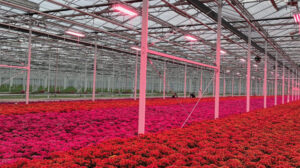The province of Almeria in Spain was known as “the desert of Europe.”
Hollywood producers had used its arid and treeless landscape for filming in westerns and even “Lawrence of Arabia”.
Today the area is dubbed “the garden of Europe”, as it is covered by hundreds of greenhouses that produce food in all seasons and are exported around the world.
In Almeria, greenhouses cover about 4% of the land, but produce 50% of the local economy.
More than 2.7 million tonnes of produce are grown in the approximately 30,000 hectares of greenhouses, contributing 1.2 billion euros to the national economy and leading to the development of a complex industrial ecosystem of suppliers and services.
Spain leads the way in greenhouse development in Europe, followed by Italy and France.
The Netherlands is also performing impressively, a country that – despite having one-third the area of Greece – hosts commercial greenhouses the size of 14,000 football pitches.
Vertical farming systems multiply the harvest per square metre, photo source: Glastuinbouw Nederland Facebook page
Facebook page of the Facebook page.
More than 3,300 greenhouse companies have developed innovative and sustainable cultivation methods and Dutch greenhouses have annual exports worth €10.8 billion.
Germany is also entering the sector dynamically, and is now home to Europe’s largest greenhouse. This is the Emsflower greenhouse, a model of a circular economy:
– The energy it consumes is produced by the photovoltaic panels installed on its roof.
– the facilities are heated exclusively by wood products, resulting from forest and garden clearances
– the crops are watered by rainwater collected in special tanks and reused.
The answer to the food crisis
Modern greenhouses are considered one of the most effective solutions to the food crisis posed by an ever-increasing human population.
The advantages they offer are multiple, as listed by Agriplast one of India’s largest agri-technology companies:
– Optimal climate and environmental control, independent of external factors. According to a study in the Journal of Cleaner Production, greenhouse farming can lead to increased productivity and reduced energy consumption.
– Extended growing season and year-round production. A study by Scientia Horticulturae found that tomato production in a greenhouse can lead to yield increases of up to 150% compared to open field production.
– Improved pest and disease management. According to a study in the International Journal of Pest Management, the use of greenhouses can significantly reduce the number of insect pests, resulting in higher quality produce and lower growing costs.
Growing exotic species based on market needs can significantly increase farm income, photo source: glastuinbouw Nederland Facebook page
Facebook page of the Facebook page of the Flowerbouwuinstuin.com
– Increased efficiency of resources such as water, energy and fertilizers. A study in the Agricultural Water Management Journal found that efficient greenhouse irrigation systems can save up to 50% water compared to traditional agricultural methods. In addition, greenhouses equipped with energy-saving technologies, such as solar panels and heat recovery systems, can reduce overall energy costs.
– Increased crop diversity and specialization. Greenhouses allow farmers to grow a wide range of crops regardless of geographic location or climate, such as exotic or out-of-season produce, achieving higher market prices.
– Vertical cultivation and space optimization.
By using vertical farming systems, such as hydroponics, aeroponics or aquaculture, farmers can use space more efficiently. This approach is particularly beneficial in urban agriculture, where land is scarce and expensive. A study in the journal Sustainability found that vertical farming in greenhouses can yield up to 11 times more produce per unit area compared to traditional farming methods.
More efficient operation of greenhouses requires modern equipment and the introduction of cutting-edge technology, photo source: Glastuinbouw Nederland Facebook page
Facebook page on Facebook Facebook page
Facebook page.
– Enhanced environmental impact and sustainability
By carefully managing and using resources through closed-loop systems, greenhouses can reduce water use, minimise soil degradation and reduce pollutant emissions. In addition, greenhouses can integrate renewable energy sources and harness heat waste from other industrial activities.
– Smart agricultural technologies such as precision agriculture, IoT devices and remote monitoring systems. These technologies provide real-time data and information on plant health, growing conditions and resource use, ultimately leading to improved efficiency and decision-making for farmers.
Ask me anything
Explore related questions





